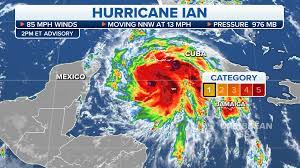
More than 2.5 million Florida customers remained without power Thursday morning after Hurricane Ian, now a tropical storm, slammed into the state as one of the most destructive hurricanes to ever hit the United States, wreaking massive destruction and floods that trapped many in their homes.
Ian was downgraded to a tropical storm Thursday morning after making landfall as a major Category 4 hurricane on Florida’s southwest coast Wednesday afternoon, bringing 150 mph winds and life-threatening storm surge.
Early Thursday, maximum sustained winds reduced to 65 mph with stronger gusts, but the storm has continued to wreak havoc as it heads northeast. Its core is predicted to travel off Florida’s east-central coast later Thursday before nearing the South Carolina coast on Friday.
Due to Hurricane Ian all Wednesday flights of Orlando International Airport are cancelled. The Category 3 hurricane Ian has hit Cuba. On Tuesday morning, Ian made landfall in Cuba after intensifying to a Category 3 major storm.
On Wednesday, the storm is anticipated to hit Florida.
The Authorities have recommended Floridian residents to complete their preparations on Tuesday and be prepared to evacuate.
As Hurricane Ian touches down in Cuba and then reemerges in the Gulf of Mexico, airports are closed.
The hurricane Ian blasted “High winds and a potentially fatal storm surge are present in western Cuba. Ian is travelling toward Western Florida at a speed of 12 mph and is anticipated to make landfall “anywhere between Fort Myers and Tampa,” “FEMA Administrator Deanne Criswell stated at a Tuesday afternoon briefing at the White House.
The NHC forecasted that the storm will veer toward the north-northeast overnight and through Wednesday while moving at a slower speed.
Later on Tuesday, Ian is anticipated to head west into the Florida Keys. According to the NHC, it will next proceed toward the west coast of Florida on Wednesday evening.
The current Hurricane Ian estimates indicate that the massive, destructive storm would make hit in Sarasota County in Florida, deeper into south than earlier forecasts but still posing a danger of statewide destruction, officials warned on Tuesday.

